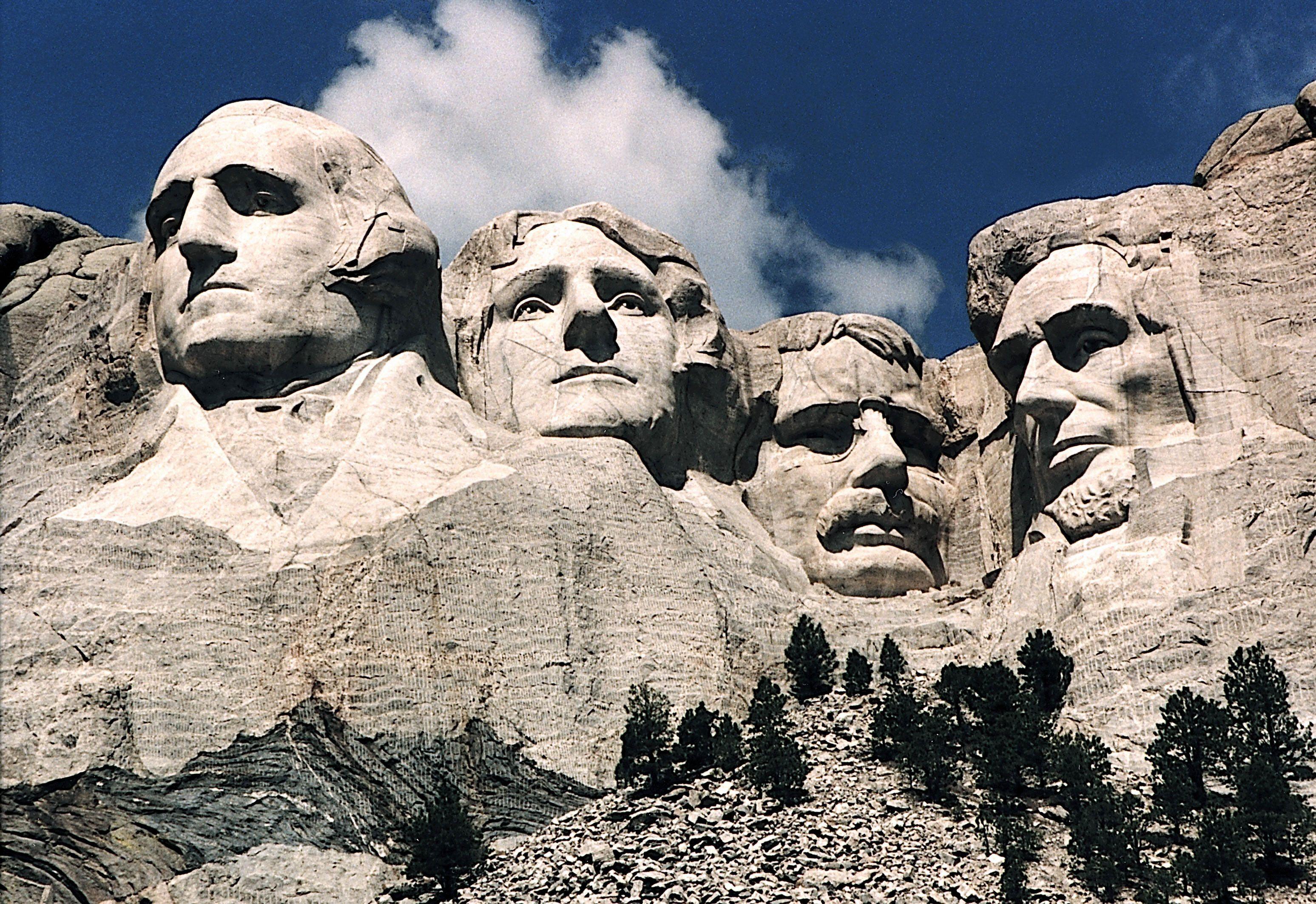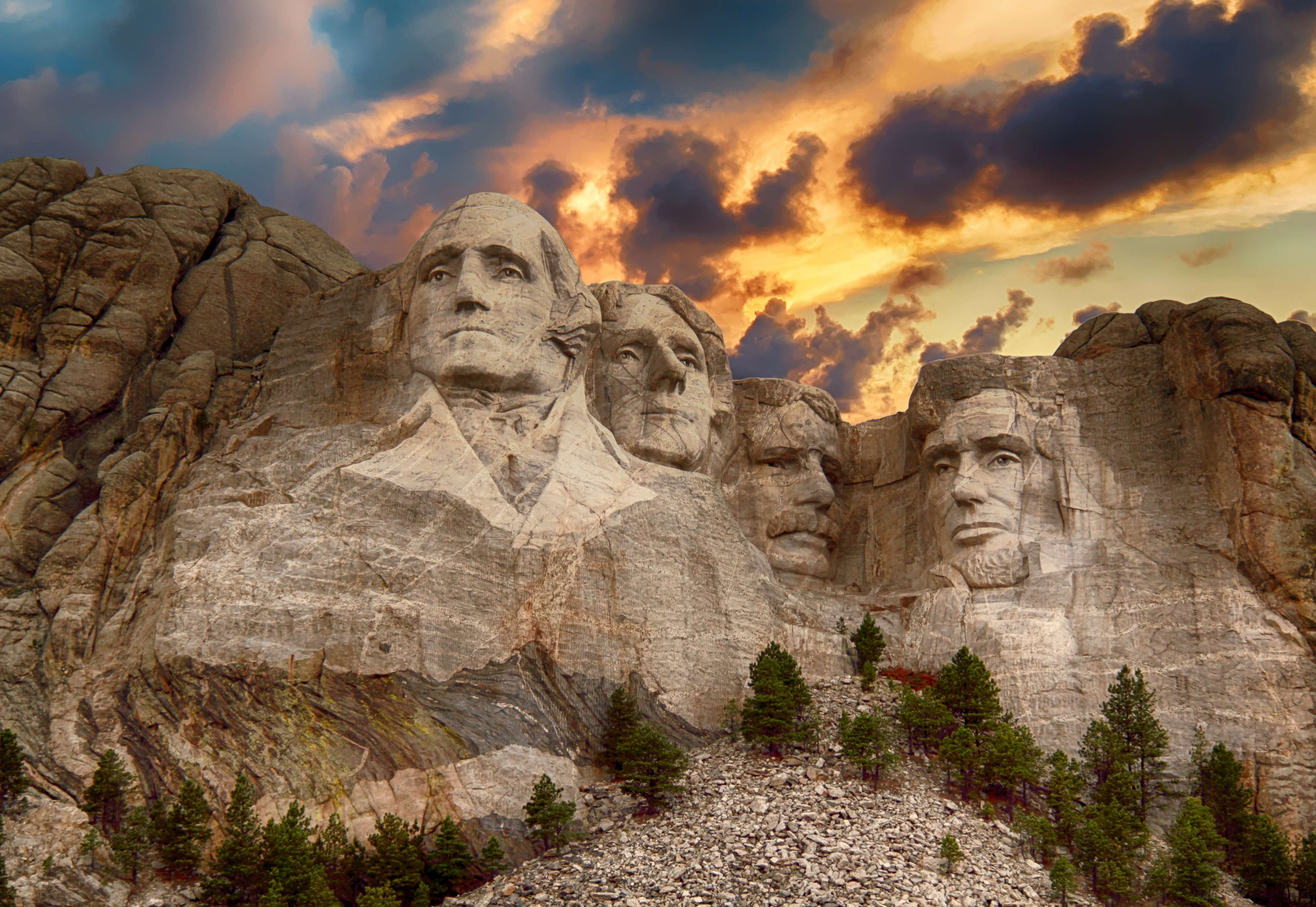4 Presidents On Mount Rushmore: The Monumental Legacy
Mount Rushmore is more than just a rock carving; it's a testament to the leadership, vision, and enduring legacy of four iconic U.S. Presidents. These faces carved into the granite cliffs of South Dakota represent the heart and soul of American history. If you're diving into the story behind Mount Rushmore, buckle up, because we're about to take a deep dive into the lives, accomplishments, and controversies surrounding the four presidents who made the cut.
When people think of Mount Rushmore, they often imagine a massive sculpture in the middle of the Black Hills, but there's so much more to the story. This isn't just about rocks and chisels—it's about the people who shaped a nation. From George Washington to Abraham Lincoln, each president on this monument has left an indelible mark on history, and their stories are as fascinating as the monument itself.
So, why were these four presidents chosen? What makes them so special that their faces were carved into a mountain? Stick around, because we're about to uncover the reasons behind the selections, their contributions to the nation, and some fun facts you probably didn't know about Mount Rushmore.
Table of Contents
- Biography of the Presidents
- George Washington: The Father of the Nation
- Thomas Jefferson: The Visionary Leader
- Theodore Roosevelt: The Progressive President
- Abraham Lincoln: The Emancipator
- A Brief History of Mount Rushmore
- The Selection Process
- Symbolism Behind the Monument
- Controversies Surrounding Mount Rushmore
- Mount Rushmore as a Tourist Attraction
- Preserving the Legacy
Biography of the Presidents
Before we dive into the specifics, let's get to know the four presidents who grace the face of Mount Rushmore. Each of them brought something unique to the table, and their contributions to the United States are undeniable.
| President | Term | Key Achievements |
|---|---|---|
| George Washington | 1789–1797 | First President, established many presidential traditions. |
| Thomas Jefferson | 1801–1809 | Author of the Declaration of Independence, Louisiana Purchase. |
| Theodore Roosevelt | 1901–1909 | Conservationist, trust-busting, and expanded U.S. influence abroad. |
| Abraham Lincoln | 1861–1865 | Preserved the Union, ended slavery with the Emancipation Proclamation. |
George Washington: The Father of the Nation
George Washington is often referred to as the "Father of the Nation," and for good reason. He led the Continental Army to victory in the Revolutionary War and became the first President of the United States. His leadership during the nation's formative years set the tone for future presidents.
Why Washington?
Washington was chosen for Mount Rushmore because of his pivotal role in shaping the United States. His leadership during the war and his presidency established many of the traditions and precedents that continue to guide the office of the president today.
- First President of the United States
- Established the two-term tradition
- Created a strong federal government
Thomas Jefferson: The Visionary Leader
Thomas Jefferson was a man of many talents—a statesman, writer, and architect. As the third President of the United States, he played a crucial role in expanding the nation's territory and promoting democratic ideals.
Key Contributions
Jefferson's inclusion on Mount Rushmore is a testament to his role in expanding the nation's borders and promoting democracy. The Louisiana Purchase doubled the size of the United States, and his authorship of the Declaration of Independence remains a cornerstone of American values.
- Author of the Declaration of Independence
- Louisiana Purchase
- Advocate for education and individual rights
Theodore Roosevelt: The Progressive President
Theodore Roosevelt was a larger-than-life figure known for his energetic leadership and commitment to progressivism. His presidency marked a turning point in American history, as he tackled issues like conservation and corporate power.
Roosevelt's Legacy
Roosevelt was chosen for Mount Rushmore because of his efforts to protect the environment and promote social justice. He established national parks, broke up monopolies, and expanded the role of the federal government in regulating business.
- Conservationist, established national parks
- Trust-busting and regulation of big business
- Expanded U.S. influence abroad
Abraham Lincoln: The Emancipator
Abraham Lincoln is remembered as one of the greatest presidents in American history. His leadership during the Civil War preserved the Union and ended the institution of slavery, leaving an indelible mark on the nation.
Lincoln's Achievements
Lincoln's inclusion on Mount Rushmore is a tribute to his role in preserving the Union and ending slavery. The Emancipation Proclamation and the 13th Amendment are just two examples of his lasting impact on the nation.
- Preserved the Union during the Civil War
- Ended slavery with the Emancipation Proclamation
- Advocated for equality and justice
A Brief History of Mount Rushmore
The idea for Mount Rushmore was conceived by Doane Robinson, a South Dakota historian who wanted to create a tourist attraction that would draw visitors to the state. Sculptor Gutzon Borglum was brought in to oversee the project, which began in 1927 and took 14 years to complete.
The monument was carved using dynamite and drills, with workers dangling from cables to shape the faces of the presidents. Despite the challenges, the project was completed in 1941, and Mount Rushmore has since become one of the most iconic landmarks in the United States.
The Selection Process
The selection of the four presidents for Mount Rushmore was a deliberate process. Gutzon Borglum chose these leaders because of their contributions to the founding, expansion, and preservation of the United States. Each president represents a different era in American history, from the Revolutionary War to the Civil War.
The criteria for selection included their role in shaping the nation, their leadership during critical periods, and their lasting impact on American society. Together, these four presidents tell the story of the United States in a way that no other monument can.
Symbolism Behind the Monument
Mount Rushmore is more than just a sculpture; it's a symbol of American values and ideals. The four presidents represent different aspects of the nation's history and values:
- George Washington: Leadership and the founding of the nation.
- Thomas Jefferson: Expansion and the promotion of democracy.
- Theodore Roosevelt: Progressivism and conservation.
- Abraham Lincoln: Preservation of the Union and the end of slavery.
Controversies Surrounding Mount Rushmore
While Mount Rushmore is celebrated as a national treasure, it has also been the subject of controversy. The land on which the monument stands was originally part of the Great Sioux Reservation, and its use for the monument has been disputed by Native American groups.
Additionally, some critics argue that the monument glorifies figures who were complicit in the oppression of indigenous peoples and other marginalized groups. These debates highlight the complex history of the United States and the need for ongoing dialogue about its legacy.
Mount Rushmore as a Tourist Attraction
Today, Mount Rushmore is one of the most popular tourist attractions in the United States, drawing millions of visitors each year. The site offers breathtaking views of the Black Hills and provides a glimpse into the nation's history.
Tourists can explore the visitor center, watch a film about the monument's creation, and attend the evening lighting ceremony. The park also offers hiking trails and educational programs that help visitors better understand the significance of the monument.
Preserving the Legacy
Preserving Mount Rushmore is an ongoing effort that involves both maintenance and conservation. The National Park Service works to ensure that the monument remains in good condition, while also educating the public about its historical significance.
Efforts to preserve the legacy of Mount Rushmore include regular inspections, repairs, and educational programs. By maintaining the monument and sharing its story, we ensure that future generations can appreciate the achievements of these four presidents and the values they represent.
Kesimpulan
Mount Rushmore is more than just a monument; it's a testament to the leadership and vision of four iconic U.S. Presidents. From George Washington to Abraham Lincoln, each president on the mountain has left an indelible mark on American history. Understanding their contributions and the symbolism behind the monument helps us appreciate the legacy they left behind.
So, the next time you visit Mount Rushmore, take a moment to reflect on the stories behind the faces carved into the granite. These presidents didn't just shape the nation—they shaped the world. And remember, if you enjoyed this article, don't forget to share it with your friends or leave a comment below. Let's keep the conversation going!

Mount Rushmore Wallpapers Top Free Mount Rushmore Backgrounds

Mount Rushmore Wallpapers Top Free Mount Rushmore Backgrounds

Mount Rushmore · Free Stock Photo